Spectro CA-12 GA
Features
Most testers for starter batteries are impedance-based and only read CCA (Cold Cranking Amp). CCA relates to battery resistance that impacts engine cranking. CCA stays steady with age and the readings do not provide reliable health validation. Capacity, on the other hand, fades gradually and offers dependable end-of-life prediction. The figure below illustrates 20 aging starter batteries. All were functional at time of testing.
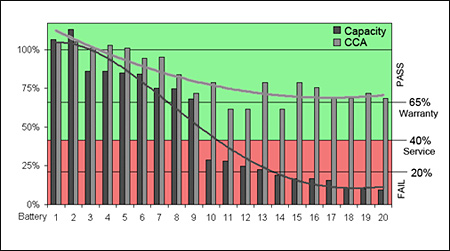
Capacity and CCA readings of aging batteries. Batteries 1 to 9 have good CCA and high capacities; batteries 10 to 20 are at the end-of-life with capacity loss. All batteries crank well.
|
Test MethodCCA was taken with the Spectro CA-12; capacity was measured with an Agilent load bank by applying full discharges according to BCI standards. |
“Is there a connection between CCA and capacity,” many wonder? To find out, Cadex examined 175 aging starter batteries and found a 0.55 correlation. Had the readings been closer to 1, the diamond dots in the figure below would have gravitated towards the red reference line. This is not the case, meaning that CCA cannot be used reliably to estimate capacity or predict the end of battery life. Observing the results closer reveals that very few batteries fail due to low CCA; it is the low capacity that eventually pulls CCA down. Note the high number of batteries straddling the 40% capacity cut-off line; the CCA line has almost none. Capacity, not CCA, governs battery health and predicts end-of-life.
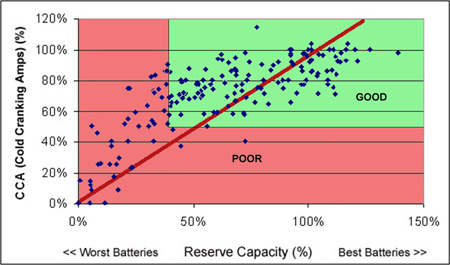 |
Relationship of CCA and capacity on 175 starter batteries The correlation is only 0.55. Passing starter batteries dwell in the green acceptance field bound by the 40% capacity threshold and the 50% CCA limit. Capacity is a more dependable health predictor than CCA. Note: Capacity and CCA tested according to SAE J537. CCA/capacity correlation is 0.55. |
Setting the capacity threshold to 40% and CCA to 50% opens the acceptance field marked in green. The truth table below summarizes the results of Spectro CA-12 GA.

Correct capacity predictions
| Battery anomaly and matrix quality govern accuracy. The generic matrix produces a correct capacity prediction of 84% for AGM (Absorbent Glass Mat) and 82% for flooded lead acid. CCA accuracy is about 90%. |
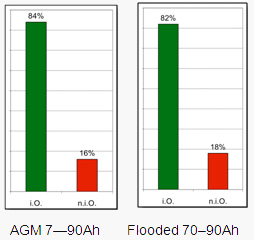 |
Quick and simple
|
The generic matrix of the Spectro CA-12 GA makes testing of mid-range starter batteries a breeze and the pass/fail capacity evaluation works well for the service sector. A pass (above 40%) assure 6–12 month additional service, batteries below this level should be replaced. The CA-12 GA also reads CCA and SoC. Simply select flooded or AGM from the menu and enter CCA and capacity ratings. The battery should have a charge of 40% or higher. If below the acceptable SoC threshold, the instrument advises to charge and retest. Connecting the probes starts the test automatically. |
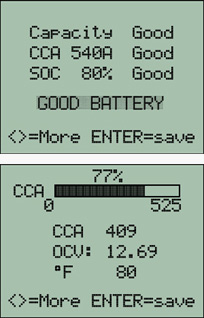 |
Capacity measurement improves prediction
Service personnel may not be aware of the low accuracies of impedance testers. Faulty batteries often pass as good, only to fail on the road, while too many good batteries are replaced by error, causing undue expenses for customers. An independent test lab examining impedance testers reveals a CCA accuracy of only 60–70% with no capacity measurement. Spectro CA-12 GA, in comparison, offers a CCA accuracy of 90% and a capacity sort accuracy of 80–90%. Capacity estimation improves battery valuation by a factor of two and more. The figure below compares the test results of a competitor (impedance tester) with the CA-12 GA.
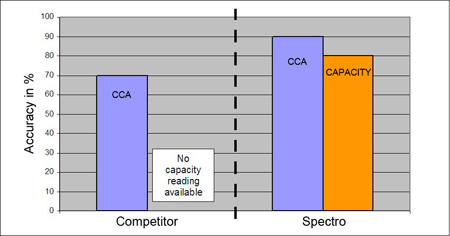 |
CCA measurement SAE J537 specifies a 30-second discharge at –18°C (0°F) with a current equal to the rated CCA ampere. To pass, the voltage cannot drop below 7.2 volts. Because of complicity, CCA readings are seldom verified. |
Summary
|
Accessories
Spectro CA-12-GA is shipped with large format “alligator” clamps standard. Additional smaller alligator clamps or pencil probes are available.
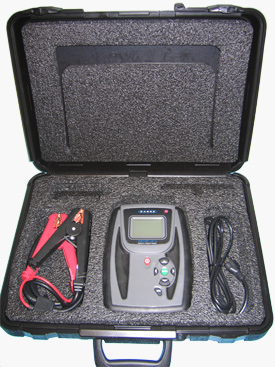 |
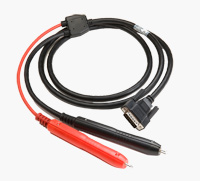 |
Specs
SYSTEM SPECIFICATIONS
|
Test Results Capacity (State-of-Health) |
Good (40-100%) Poor (0-40%) |
| Cold-Cranking Amps (CCA) |
Good (0-50%) Poor (0-50%) |
| Test Result Message |
Good Battery Replace Battery Charge and Retest (if SoC is <60%) |
| Application | Non-invasive hand-held rapid-tester for lead acid batteries. Based on multi-model electrochemical impedance spectroscopy; excitation frequencies 20-2000 Hertz. Patented algorithm. |
| Battery Types | Flooded, AGM, 12V |
| Test Conditions | 40-100% state-of-charge; tolerates steady loads of up to 30A. Reverse polarity and over-voltage protected. |
| Tests |
- Capacity; 35-105Ah or 70-210 RC minutes, built-in AGM and Flooded matrices. - CCA: 100-1200 CCA - State-of-charge in percent - Alternator test and continuity test Stores up to 150 test results |
| Test Time | Approximately 15 seconds |
| Power Source | Li-ion battery provides ~250 tests per charge; charge indicator; 3-hour charge. |
|
Physical Dimensions Weight |
ABS housing with rubber over-molds. 172 x 248 x 60.5mm (6.75" x 9.76" x 2.38") 1.10 kg (2.45 lbs) |
| Ports | RS232 |
| Environmental |
Operating temp: 0 to 40°C (32 to 104°F); Storage temp: -20°C to 70°C (-4 to 158°F) |
| Safety |
UL3101, CSA 1010, EN61010 EMI/EMC: FCC part 15 Class A, EN55011 Level A, EN61000-6-3:2001 for EMC |
| Warranty | One (1) year from the original purchase date. |
| PC-Software | PC-Companion Beta |
| Printing | Receipt printing supported by Martel MCP8830B infrared printer. |
